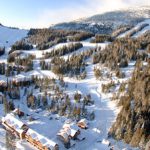For years, I have often wondered why, in such ’tough economic times’, the very expensive Sea to Sky highway was not tolled. I’ve called for it, many of you have called for it, and last year, even Vancouver Mayor Gregor Robertson called for it as an avenue for revenue to solve Translinks money woes.
What Gregor did not know at the time ( and neither did most of us ) is that the Sea to Sky highway is a very lucrative avenue for revenue – but not for the province of BC. In actuality, the Sea to Sky highway is costing the provincial government money, every single time a vehicle drives up or down the highway.
Sources have revealed to me, that the BC government inked a hidden toll into the agreement to build and maintain the Sea to Sky highway, via a model commonly known in the transportation/road-building industry as a
” shadow toll”.
As a result, the provincial government will be paying a shadow toll on every vehicle that uses the highway for the duration of the agreement, which is 25 years. Where does that toll go? To the private company that operates and maintain the road – otherwise known as the
‘concessionaire’ in the agreement with the province.
Below is a screen shot of a page taken from a ‘strictly confidential’ document titled ” PPP’s- a Private Partners Perspective“,which is downloadable here in PDF format :
Macquarie shadow tolls You can click on the screen shot to see the larger view.
Shadow tolls are quite simply explained as hidden tolls that the government pays to a private partner in a P3 project as an incentive to get a return on their initial and long term investment in the project – a method to sweeten the pot, some might say .
Rather than you and I paying a direct toll each and every time we travel the Sea to Sky highway, the BC government has been paying a fee based on actual vehicle usage, for the length of the highway. That fee is forwarded to the private partner, along with their other regular, agreed- upon payments. So, the more people who drive the highway, the more money that private partner hauls in via those crafty shadow tolls…. no wonder the province pushes Whistler tourism!
Ironically, while you are sitting there, trying to take all this in and wondering why you’ve never heard about this, just know that this has not been a secret within the industry, or among other governments.
In fact, further investigation has revealed that while the BC government failed to share this information with all of us, there are several examples online indicating that the BC government has been openly sharing the details of the financing agreement with other transportation departments and ministries in governments around the world, who refer to the Sea to Sky shadow toll arrangement as a steller case example.
The following screen shot comes from a PDF document that I was directed to over the weekend, and was available until this evening when it suddenly became inaccesible for a period of time after I left a message for the fellow who authored the report for a conference in 2009. (Dave has not returned my call yet )
Thankfully, I had already saved this file – which can be viewed here in a PDF format :
winterolympicsgoogle docs – however I did obtain screen shots of the most important pages of the document that again, details the shadow toll on the Sea to Sky highway, which you see here below. Click on the screen shot to bring up the larger view, and read the PDF document above to see the entire paper on the Sea to Sky highway in relation to 2010 winter olympics :
If you still need more proof there is a hidden toll being paid by the government to the private partner, here is a link to a webcached page from 2005, of an American Annual Privatization report from the
Reason Foundation. And here is an excerpt :
Several new PPP transportation projects are under way in Canada. In British Columbia, a long-term concession approach is being used for the $500 million Golden Ears toll bridge project across the Fraser River. Three private-sector teams have been short-listed to provide formal proposals. BC is using a design-build-finance-operate approach to modernize the (non-toll) Sea-to-Sky Highway in time for the 2010 Winter Olympics. The concession for the $340 million project will run for 25 years, and the government will provide shadow toll payments over the life of the agreement. A similar approach is being used in Alberta for a $400 million project to design, build, finance, and maintain an 11 km. section of the ring road around Edmonton. The term of this deal will be 30 years.
Now, I would really like to tell you who in the BC government, or who on the S2S team is handing out all this information to everyone but the people of BC, but I can’t. No one will talk.
The BC government never released the details of this ‘shadow toll’ to the public, and it was only mentioned in passing in the
main agreement.Although the Concession Agreement specifically prohibits a toll being charged by the concessionaire in the preamble, there is an oblique reference to the hidden toll in Section 32, which outlines how performance payments are to be calculated.
Excerpt:
32.1.2 The aggregate monthly payments made on account of the Monthly Availability
Payment, Monthly Vehicle Usage Payment and Monthly Traffic Management
Payment components of the Total Performance Payment in respect of a Contract
Year, together with the Safety Performance Payment and DELETED for that
Contract Year, will be adjusted in accordance with Section 32.2 [Annual
Reconciliation].
The Annex to this agreement has all the juicy details, but again, since it has never been released – to my knowledge – this simply leaves me – and the rest of BC- with a lot more questions than answers.
First of all, how does the government track,and record, the number of vehicles using the Sea to Sky highway, in order to determine the amount to pay to the private partner ?
My sources directed me to the company that designed the traffic management systems for the Sea to Sky highway,
ICX Technologies. On their site, one can find
several case studies, again, downloadable with a PDF document that describes the system they installed to monitor traffic on the highway, here :
Case-Study_Sea-to-Sky-Hwy
Excerpt:
– Portable LED-based dynamic message signs that provide advance notification of
construction activities and incidents
– Fixed video cameras that are image-capture-capable are used to capture visual traffic
conditions
– Microwave-based vehicle detection stations that provide speed, volume and occupancy
data
– License plate readers implementing character recognition technologies, such as license
plate readers providing travel time information
– Communication capabilities for all ITS field sites provided through the use of wireless technologies
At the time this document was produced, the data from the sensors was being transmitted via wireless to a Peter Kiewit and Sons office in downtown Vancouver, however the document goes on to state that ” future provisions of the project will allow for the transfer of traffic data and images to project and ministry websites.”
Think about what I am telling you.
A highly sophisticated system not only capable of counting vehicles, but also the number of passenger and licence plates, was, and may well still be, collecting personal and private data from drivers unaware this was even occurring.
I don’t know about you, but I have a big problem with my personal and vehicle information being tracked,recorded and transmitted to an unknown location with unknown security protocols for an unknown amount of time. In fact, I doubt this is even acceptable under privacy legislation, considering this also was never made apparent to drivers using that highway. Think about the implications of the use of this technology during the Olympics, if licence plate data was accessed for security purposes.
We know Gordon Campbell and Kevin Falcon said all along that the Sea to Sky Highway was going to be a toll-free highway. Clearly, they were not being truthful with us. Lies of omission are lies nonetheless.
All of these shadow tolls are coming out of government coffers, which ultimately comes out of our pockets. You, and I, and every other taxpayer in this province are literally paying twice for this road every time a vehicle drives up or down it, and until now, no one other than those involved in the industry has spoken openly about it.
2002 Legislative Session: 3rd Session, 37th Parliament:
HANSARDHon. J. Reid: It states in the policy document that was released with this piece of proposed legislation, which was actually introduced in the House last spring, that the business case for any toll road would have to have a calculation where the benefits to the travelling public would have to exceed the tolls. Along with that there has to be a business case that, in order to get a private sector…. Obviously, if your tolls are too high, people won’t use that route, and they can’t have a return on investment. There does have to be a reason that works.
When we talk about public-private partnerships, those can be a range of different agreements from complete private sector investment to, obviously, the complete public sector investment and any range in between. If the government has to put in a certain amount in order to bring down the tolls so they meet this criterion and so there is a business case that can be made, that’s all within that realm of options available to government in looking at how we’re going to move forward and finance projects.
It makes no sense whatsoever, to think of anyone investing and building a road where the tolls were so high that people wouldn’t use it. We have to look at business cases where it’s workable. The example I used when we were discussing this in committee stage on Bill 62 was in the lower mainland, where you have high traffic volumes. The higher the traffic volumes the more sense it makes, because then you’re providing a good benefit, and it brings the tolls down low enough so people are enjoying that benefit and are willing to use those roads, and it works out well for the different parties involved.
There is a full range of opportunity and possibility, but there are a lot of natural constraints around this where it just does not make sense to use toll roads. It doesn’t make sense from a business case, where you wouldn’t attract an investor, and it wouldn’t make sense if the tolls are too high and they exceed the benefit that people are receiving. There are natural, commonsense restraints around this. There is limited application of this. We do believe that there are some applications, and the lower mainland is a case in point, around the gateway and another crossing of the Fraser River.
J. Kwan: Are shadow tolls captured by the definition of tolls in the bill?
Hon. J. Reid: A shadow toll is where the government would pay a toll per vehicle, rather than a direct user-pay. Under the definition of toll in this section, it would include the concept of a shadow toll.
J. Kwan: Could the minister please explain what a shadow toll is? I actually don’t know what a shadow toll is. That was in the discussion paper. It’s not incorporated in the act. But what is it? In some ways, I suppose one could argue that it might just be a hidden tax.
Hon. J. Reid: A shadow toll is a situation where you have a private investor who has built a road or a section of road, but the arrangement is that vehicles themselves don’t stop and pay the toll. There is a calculation of the vehicles using the roadway, and the government compensates the company based on the usage of that roadway.
[1550]
J. Kwan: So the government pays for the toll and to the private sector, whoever happens to be operating the roadway. That’s incorporated within the definition of tolls in this bill. Are Forests roads captured in the definition of highways, then, in this act?
Hon. J. Reid: Mr. Chair, I appreciate the question. I think it’s an excellent question. I just want to verify some legal wording around this, so I will be responding to that question as soon as that information comes in to me.
J. Kwan: I assume that the answer will come at some point during this debate — yes? Thank you.
Just back to the issue around shadow tolls for one minute. Why isn’t there a specific definition to say what a shadow toll is? In the definitions section, a “toll means a charge for the use of some or all of a concession highway by a vehicle.” When you read that, one assumes that the charge is actually to the consumer. Although if government pays for it, it is also charged to the consumer, but it’s not the direct charge. Why isn’t that term “shadow toll” in the definition section? It was in the discussion paper.
Hon. J. Reid: The definitions section of the act is around legal terms, and shadow toll is a concept. In order to give validity to the act, it isn’t necessary to have that under the definitions.
snip
Isn’t that just setting the scene for the increased likelihood that these hidden shadow tolls would soon be used more and more often? I think so. By not defining shadow tolls as a hidden toll nonetheless, the goverment has been able to easily work this into the P3 scene with ease.
It is this very reason that the government and the road building industry would rather you not know all this information, and it is the inherent lack of transparency and secretiveness that alarms both myself and soon, the rest of the public.
If the public becomes aware of these hidden tolls, it potentially prevents future projects from being set up this way, and makes it much harder to entice a private partner with thoughts of lovely extra payments coming their way.
Ironically though, it is this very secretiveness combined with the substantially increased costs associated with this model, that is behind the decision of many foreign governments to move away from shadow tolling in a time when the public demands more accountability and trust in their governments. So why is our government using it?
Who was in charge of the transportation ministry at the time this deal was done?
But he wasn’t alone in all of this, certainly not, he was part and parcel with the most unpopular premier on earth, Gordon Campbell, who pushed the highway along speedily when it became apparent it was conditional to the 2010 Olympic bid.
Unfortunately, the information given to me by my source, only leads to more disturbing questions than answers.
How many other projects been arranged using Shadow Tolls as a part of the deal? The Pitt Meadows bridge perhaps? Kicking Horse Canyon? That Canada line that has been plagued with rumours of the equivalent in a ” rider toll”?
Are any P3 projects in other sectors subject to this same kind of hidden toll, or fees based on other usage?
What has, or what is the government doing to recoup the costs of paying the toll to the private partner? And why is these constant payments not openly included in the final cost of the project?
Has the government broken any privacy laws by scanning licence plates and using microwave technology to determine occupancy of the vehicles, now or during the last 5 years it has been in active use? Who is in charge of our licence plate information now, where is it being stored and what assurances do motorists have this information is being stored appropriately, and not sitting in a Kiewit office somewhere?
And while the government will surely scramble to provide us all with some clear, concise and accurate answers, clearly, this is qualifies as more than reason 101 of why Gordon Campbell must go.
( Suffice it to say that this will also begin an entirely new list for Kevin Falcon, who was also minister in charge of the Port Mann bridge debacle. And how about we toss in Shirley Bond, the new minister as well, for she had to have known about this as well, less confess to ignorance of her own portfolio. Not that we haven’t seen that done before… )
Now, how about some answers to all of these questions? Any takers
Laila Yuile is a writer and activist who lives in northern BC. Reprinted from her blog, I’m Laila Yuile and This Is How I See It with the author’s kind permission. Related News
by Contributor on December 23rd, 2024
by Contributor on December 5th, 2024
by Wildsight on December 1st, 2024
by DriveSmartBC on December 1st, 2024




























